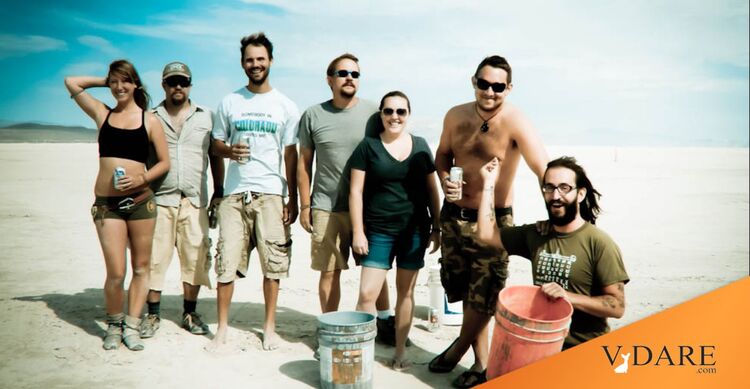
Why Wasn’t A Cut-Off Burning Man A Disaster Like, Say, Katrina?
09/04/2023
Photo credit: Jessica Reeder, Creative Commons License CC-BY-SA.
The Burning Man neo-pagan arts festival in the Nevada desert was hit by a modest amount of rain which turned the talcum powder-like dust in the dry lake bed into impassable super-mud. So, for a day or two, nobody could get in or out and attendees were advised to conserve their supplies in case it kept raining and they were stuck for a week.
This elicited much schadenfreude from the rest of America about how the hippies and techies would soon be eating each other in an inevitable descent to barbarism.
But nothing much happened other than a lot of mud, which is now starting to dry up.
One reason there was never much chance of anarchic violence is the Northern California–dominated demographics of the attendees, which I’ve written about before:
2011: Burning Man as a Whitopia
2012: “Few African Americans at Burning Man”
2015: Burning Man Festival Co-Founder Talks Frankly About Race
In the last post, I quote from Burning Man cofounder Larry Hogan in The Guardian:
Burning Man founder: ‘Black folks don’t like to camp as much as white folks’
Larry Harvey discusses lack of racial diversity and the allegation that Silicon Valley bosses in luxury camps are destroying the festival’s egalitarian ethos
Larry Harvey: ‘We’re not going to set racial quotas.’
Steven W Thrasher
Burning Man founder Larry Harvey has countered criticism of the lack of racial diversity at the festival by saying that part of the reason there are so few black attendees (known as burners) is that “I don’t think black folks like to camp as much as white folks”.
In an interview with the Guardian, Harvey vowed that “we’re not going to set racial quotas”, defended the presence of rich Silicon Valley executives at the festival, and said he will personally go undercover this week to investigate the luxurious camps of ultra-wealthy tech bosses said by the New York Times to boast chefs, air conditioning and servants.
According to the most recent Black Rock city census, compiled yearly by a team of academic demographers and anthropologists to determine the makeup of the festival, 87% of burners identified as white; 6% identified as Hispanic, 6% as Asian, and 2% as Native Americans (figures rounded) — on the latter of whose ancestral lands the event occurs. The smallest demographic of burners — 1.3% — identified as black. According to the census, which also measures income, this means that the temporary city is home to twice as many people who earn $300,000 a year as it is to black people.
Hogan points out that his ex-wife is Jamaican, so he lived in a rare black neighborhood in San Francisco:
… The rest of the year, Harvey lives in the historically black Fillmore neighborhood of San Francisco. “My wife is from Jamaica. My ex-wife. My stepchildren — and then there’s my son. So, it’s a biracial family.
“In my neighbourhood,” he added, “the thing to do was to get a good-looking car, and people would sit on stoops, and you’d stop your car in the middle of the street and you’d start talking. That was society. And that involved a lot of display, a lot of dress, a lot of attention to style. But the idea of getting down in the dirt? Not particularly popular.”
In general, the people in charge of Burning Man seem pretty practical-minded, like this guy. Back in 1967, San Francisco’s Summer of Love featured hippie fests in Golden Gate Park, but pretty quickly the Oakland Community heard about drugged-up white chicks and started showing up, so the Haight-Ashbury scene curdled pretty fast.
So Burning Man, which started in San Francisco, was pretty quickly moved over the Sierras so that it would be expensive to get to and to get into.
I’m interested in the demographic breakdown among whites at Burning Man: I’d bet that Burning Man appeals more to sun-worshipping Northern Europeans than to Southern Europeans.
